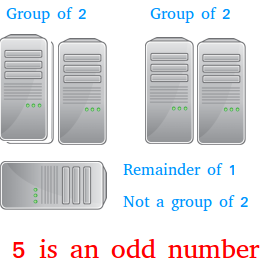What is an odd number ? Definition and examples.
An odd number is an integer that cannot be grouped in twos. For example, it is not possible to group 5 computers in groups of twos only. Therefore, 5 is an odd number.

As you can see from the illustration above, an odd number is always going to have a remainder of 1 when you try to make groups of twos.
In the example above, there are two groups of two computers and a remainder of 1 computer. In other words, 5 = 2 × 2 + 1
7 will give you 3 groups of 2 and a remainder of 1 and we can write it as
7 = 2 × 3 + 1
9 is also an odd number and we can write it as 9 = 2 × 4 + 1
A negative integer can also be an odd number as long as you can show that there is a remainder of 1.
For example, -5 = 2 × -3 + 1 and -7 = 2 × -4 + 1
Do you see a pattern? The numbers in red do not change. The number in the middle is an integer.
Formal definition of odd number :
Let n be an integer, then 2n + 1 is an odd number.
By definition, 1 is an odd number since you cannot make a group of 2 with 1.

The definition of odd numbers apply only to integers! It would not make sense to say that a fraction, a decimal, or a real number is an odd number.